BUICK RIVIERA 1993 Owners Manual
Manufacturer: BUICK, Model Year: 1993, Model line: RIVIERA, Model: BUICK RIVIERA 1993Pages: 324, PDF Size: 16.01 MB
Page 241 of 324
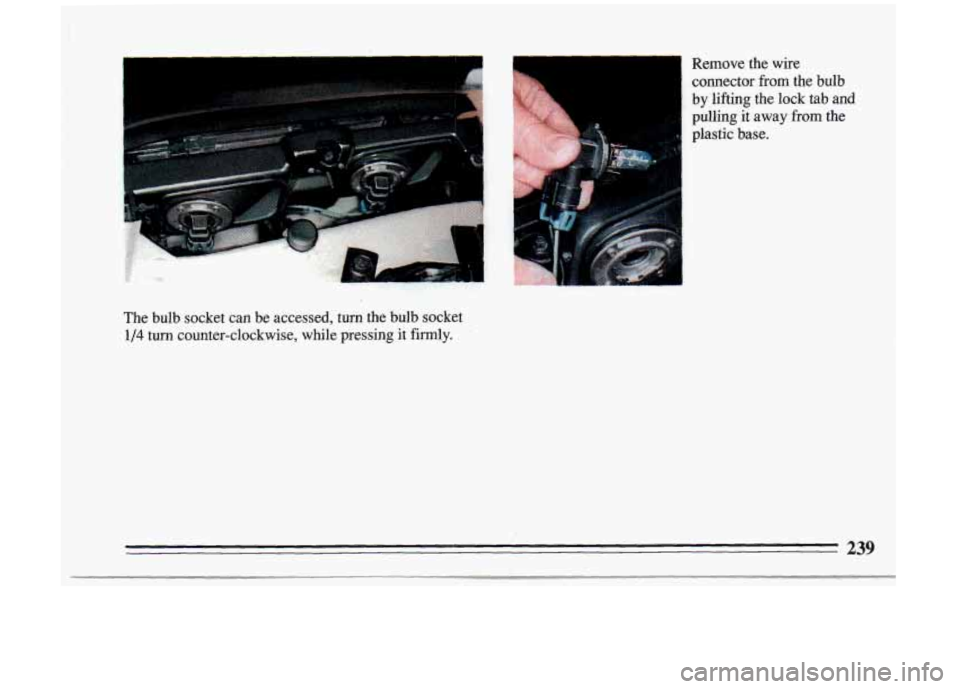
The bulb socket can De accessed, turn the bulb socket
1/4 turn counter-clockwise, while pressing it firmly. Remove the wire
connector
from the bulb
by lifting the
lock tab and
pulling it away from the
plastic base.
239
Page 242 of 324
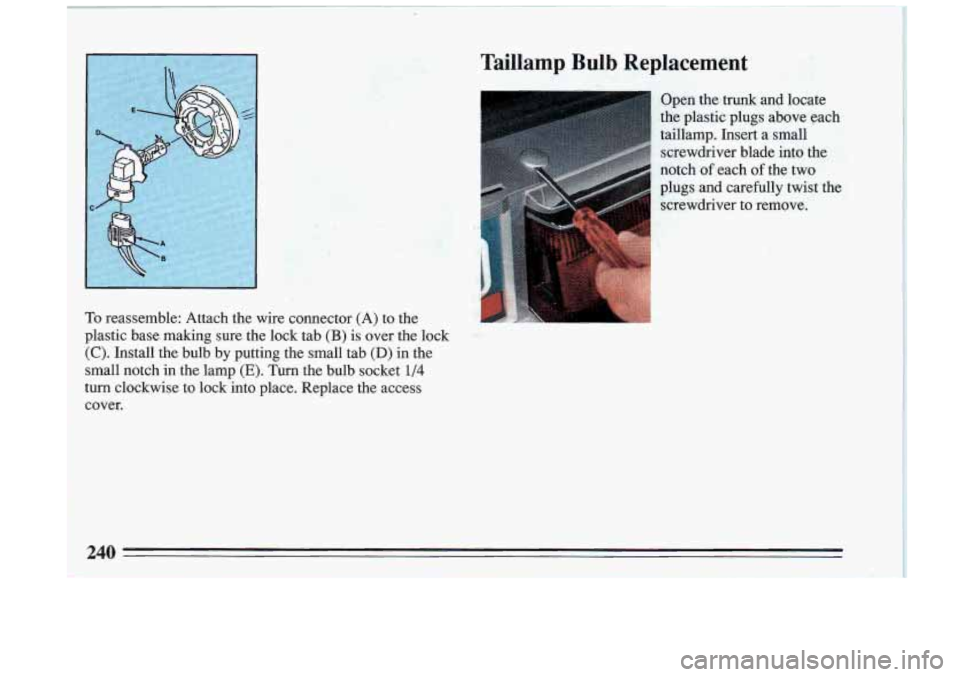
To reassemble: Attach the wire connector (A) to the
$astic base making sure the lock tab
(B) is over the lock
(C). Install the bulb by putting the small tab (D) in the
small notch in the lamp (E). Turn the bulb socket 114
turn clockwise to lock into place. Replace the access
cover.
240
Page 243 of 324
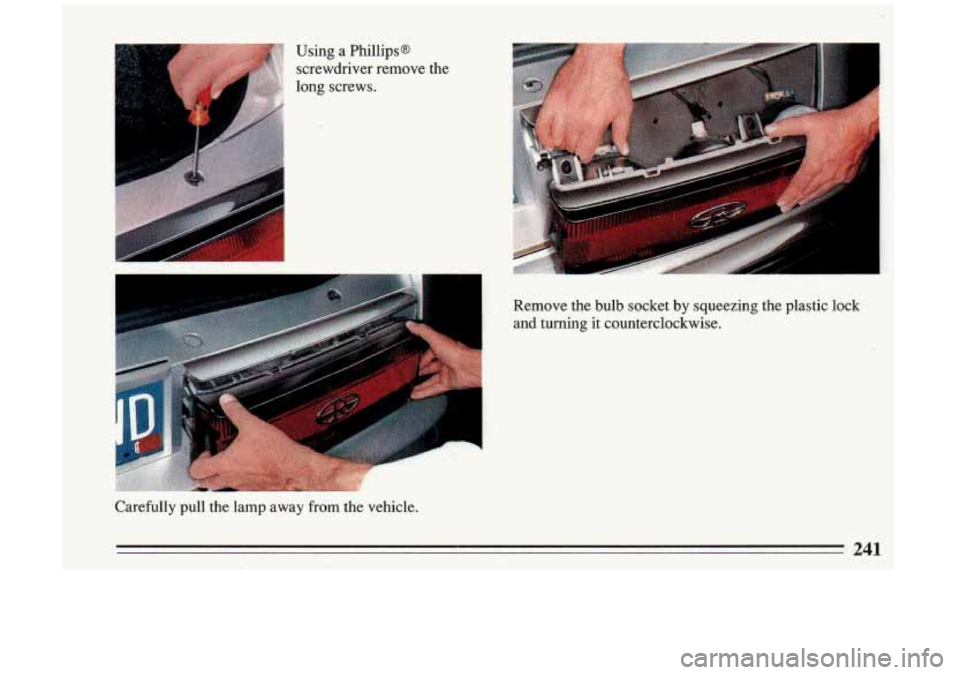
r
Using a Phillips@
screwdriver remove the
long screws.
d,T&* g&@ 1 * *'.
.-
Remove the bulb socket by squeezing the plastic lock
and turning
it counterclockwise.
i
Carefully pull the lamp away from the vehicle.
241
Page 244 of 324
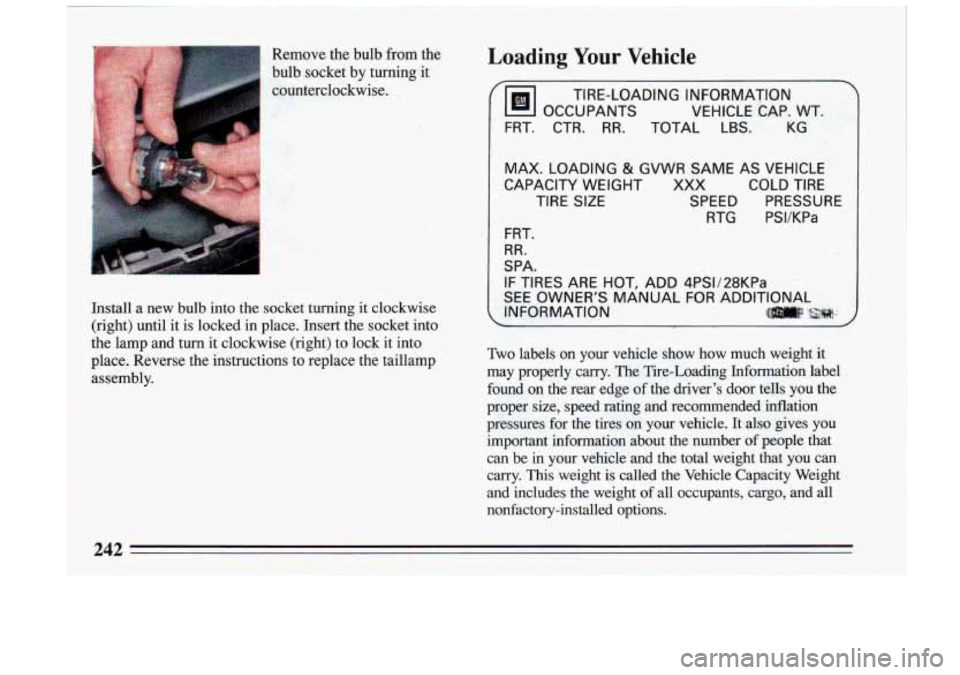
Remove the bulb from the Loading Your Vehicle
bulb socket by turning it
counterclockwise.
%I OCCUPANTS VEHICLE CAP. WT.
I
TIRE-LOADING INFORMATION,
FRT. CTR. RR. TOTAL
LBS. KG
MAX. LOADING & GVWR SAME AS VEHICLE
CAPACITY WEIGHT XXX COLD
TIRE
TIRE SIZE SPEED PRESSURE
RTG PSI/KPa
FRT.
RR.
SPA.
IF TIRES ARE HOT, ADD 4PS1128KPa
SEE OWNER'S MANUAL FOR ADDITIONAL
1 Install a new bulb into the socket turning it clockwise INFORMATION 111-p ?j$##..:,
(right) until it is locked in place. Insert the socket into \
the lamp and turn it clockwise (right) to lock it into
place. Reverse the instructions to replace the taillamp assembly.
Two labels on your vehicle show how much weight it
may properly carry. The Tire-Loading Information label
found on the rear edge of the driver's door tells you the
proper size, speed rating and recommended inflation
pressures for the tires on your vehicle. It also gives you
important information about the number of people that can be in your vehicle and the total weight that you can
carry. This weight is called the Vehicle Capacity Weight
and includes the weight
of all occupants, cargo, and all
nonfactory-installed options.
242
Page 245 of 324
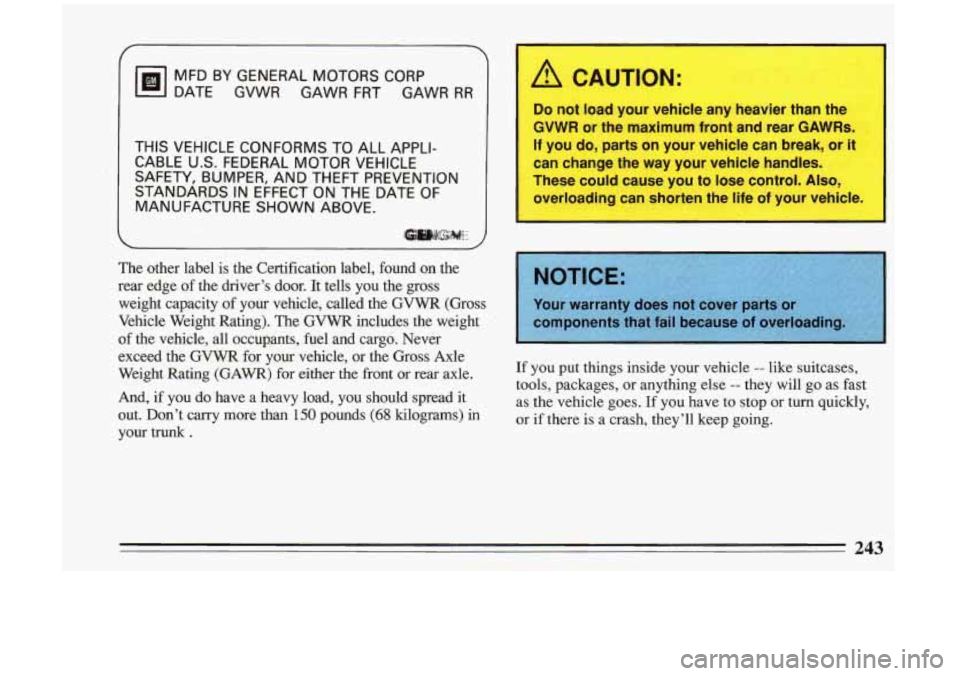
7
Isl
MFD BY GENERAL MOTORS CORP
DATE GVWR GAWR FRT GAWR
RR
THIS VEHICLE CONFORMS TO ALL APPLI-
CABLE US. FEDERAL MOTOR VEHICLE
SAFETY, BUMPER, AND THEFT PREVENTION
STANDARDS IN EFFECT
ON THE DATE OF
MANUFACTURE SHOWN ABOVE.
@iwlIk$#d!!i
The other label is the Certification label, found on the
rear edge of the driver’s door. It tells you the
gross
weight capacity of your vehicle, called the GVWR (Gross
Vehicle Weight Rating). The
GVWR includes the weight
of the vehicle, all occupants, fuel and cargo. Never
exceed the GVWR for your vehicle, or the Gross Axle
Weight Rating
(GAWR) for either the front or rear axle.
And, if you do have a heavy load, YOU should spread it
out. Don’t carry more than
150 pounds (68 kilograms) in
your trunk
.
ur vehicle any heavier than the
:imum front
and rear GAWRs.
1 your vehicle can break, or it
lay your vehicle handles.
;e you
to lose control. Ako,
;horten the life of your vehicle. I
If you put things inside your vehicle -- like suitcases,
tools, packages, or anything else
-- they will go as fast
as the vehicle goes.
If you have to stop or turn quickly,
or if there
is a crash, they’ll keep going.
243
Page 246 of 324
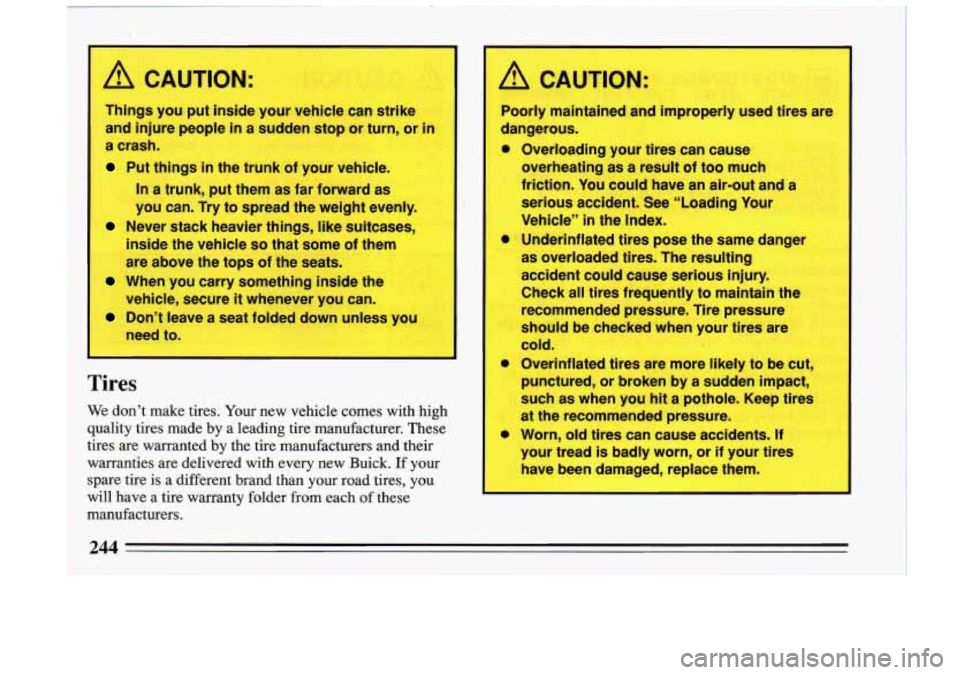
TI
I
A CAUTION:
1 Things you put inside your vehicle can strike
! I
' and injure people in a sudden stop or turn, or in
j a crash.
Put things in the trunk of your vehicle.
In a trunk, put them as far forward as
you can. Try to spread the weight evenly.
Never stack heavier things, like suitcases,
inside the vehicle
so that some of them
are above the tops of the seats.
vehicle, secure it whenever you can.
need to.
When you carry something inside the
Don't leave a seat folded down unless you
Tires
We don't make tires. Your new vehicle comes-with high
quality tires made by a leading tire manufacturer. These
tires are warranted by the tire manufacturers and their warranties are delivered with every new Buick.
If your
spare tire is a different brand than your road tires, you
will have
a tire warranty folder from each of these
manufacturers.
I
A?!,, CAUTION:
1
Poorly maintained and' i!rn,pvaget.ly used tires are
dangemus.
* Owrloadi'ng your tlires can cause
overheatingl
as a result of too much,
friction. You could have an air-crut and a
Vehicle"
in the Index.
Underinflated tires pose tlhe same danger
6s overloaded tires. The viesulting
acci'dent could cause seriouls injury.
Check all1 tires frequently to msintdn the "
recormmended pressure,. Tire (pressure
shoul,d
be checked w'hsn your tires a're
I * averinflated tires are moire likely t'o be ,GU!~,
punctured, 'or broken by a sudden impact,,
such as when you, hit a pothole. Keep tires
at the recommended pres'sura
0 Worn, old tires can cause accidents. If
your tread is ;badily worm,, lor if your tires
have been damaged, replace them
I serious accident. See "kading Your
Gold.
244
Page 247 of 324
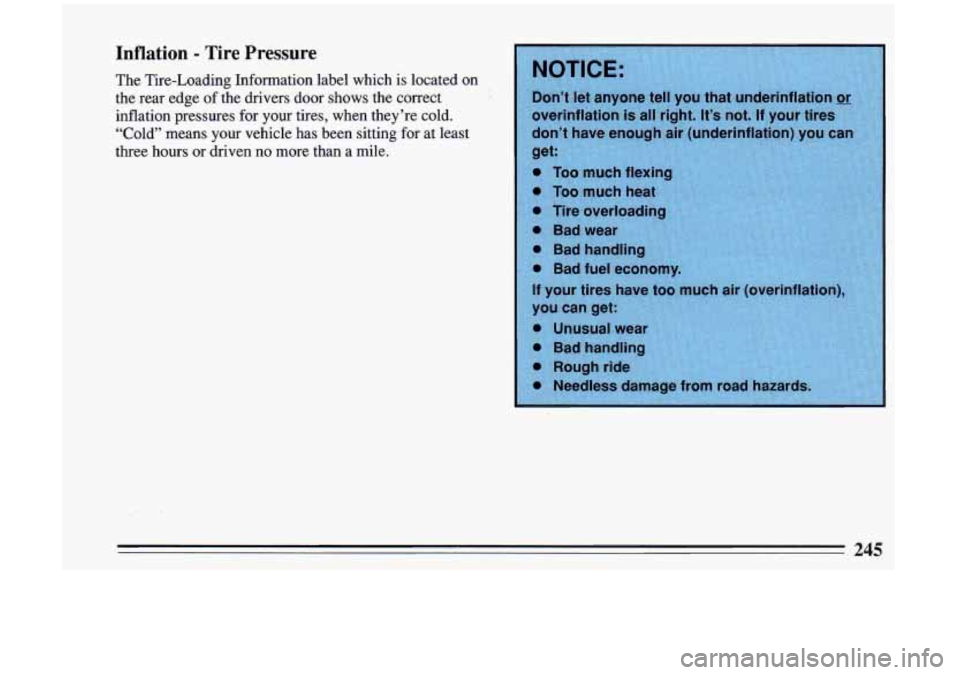
Inflation - Tire Pressure
The Tire-Loading Information label which is located on
the rear edge
of the drivers door shows the correct
inflation pressures
for your tires, when they’re cold.
“Cold” means your vehicle has been sitting for at least
three hours or driven no more than a mile.
245
Page 248 of 324
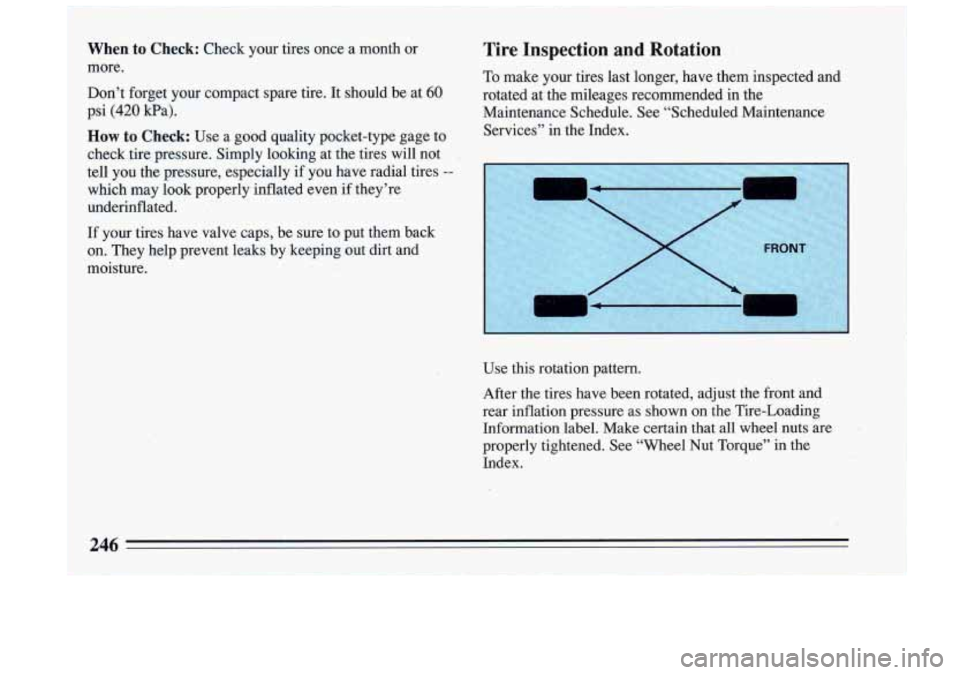
When to Check: Check your tires once a month or
more.
Don’t forget your compact spare tire. It should be at
60
psi (420 kPa).
I
How to Check: Use a good quality pocket-type gage to
check tire pressure. Simply looking at the tires will not
tell you the pressure, especially
if you have radial tires --
which may look properly inflated even if they’re
underinflated.
If your tires have valve caps, be sure to put them back on. They help prevent leaks .by keeping out dirt and
moisture.
Tire Inspection and Rotation
To make your tires last longer, have them inspected and
rotated at the mileages recommended
in the
Maintenance, Schedule. See “Scheduled Maintenance
Services”
in the Index.
r-
Use this rotation pattern.
After the tires have been rotated, adjust the front and
rear inflation pressure
as shown on the Tire-Loading
Information label. Make certain that all wheel nuts are
properly tightened. See “Wheel Nut Torque”
in the
Index.
Page 249 of 324
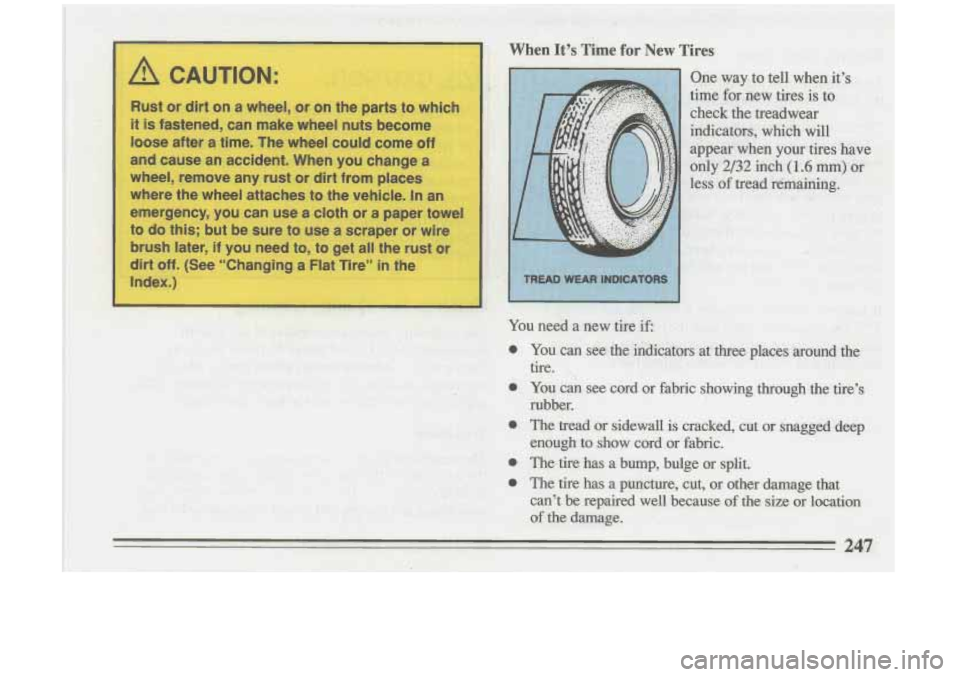
A CAUTION:
Page 250 of 324
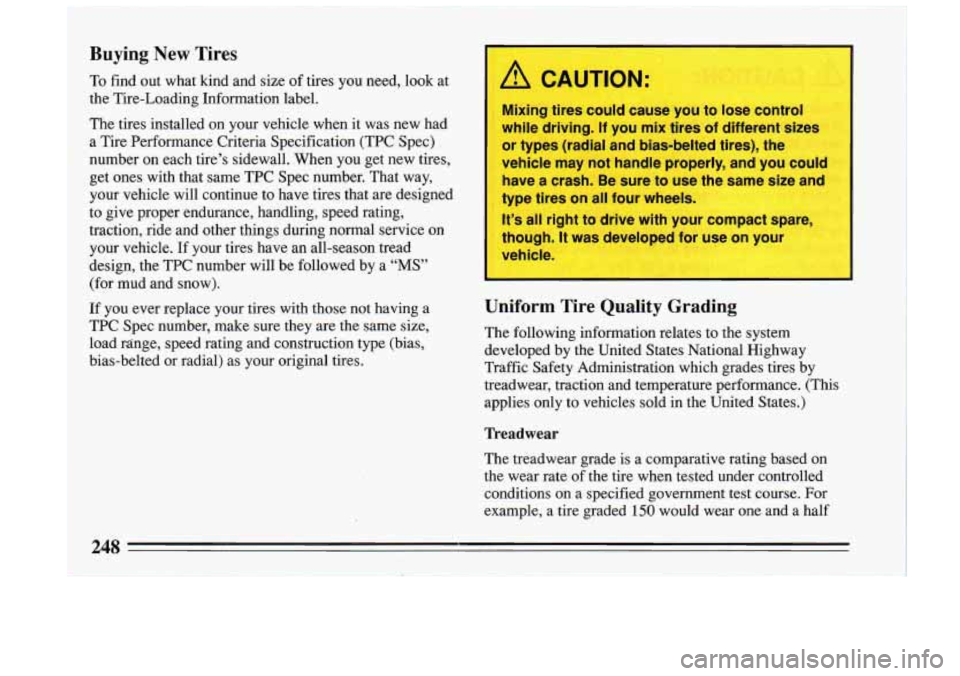
Buying New .Tires
To find out what kind and size of tires you need, look at
:the Tire-Loading Information label.
The tires installed on your vehicle when it was new had
a Tire Performance Criteria Specification (TPC Spec)
number on each tire’s sidewall. When you get new tires,
:get ones with that same TPC Spec number. That way,
*your vehicle will continue to have tires that are designed
to give proper endurance, handling, speed rating,
traction, ride and other things during normal service on
your vehicle. If your tires have an all-season tread
design, the TPC number will be followed by a
“MS’,
(for mud and snow).
;If you ever replace your tires with those not having a
!.TPC Spec number, make sure they are the same size,
load rdnge, speed rating and construction type (bias,
bias-belted or radial) as your original tires.
, A CAUTION:
Mixing tires could cause you to lose control
while driving.
If you mix tires of different sizes
or types (radial and ‘bias-belted tires), the
1 vehicle may not handle properly, and you cou’ ’
have a crash. Be sure to use the same size ana
type tires on all four wheels.
It’s
all right to drive with your compact spa
though. It was developed for use
on your
vehicle.
~1
Uniform Tire Quality Grading
The following information relates to the system
developed by the United States National Highway
Traffic Safety Administration which grades tires by
treadwear, traction and temperature performance. (This
applies only to vehicles~ sold.in the United States.)
Treadwear
The treadwear grade is a comparative rating based on
the wear rate of the tire when tested under controlled
conditions on a specified government test course. For
example, a tire graded
150 would wear one and a half
248